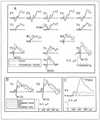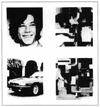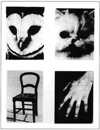Electrophysiological Studies of Face Perception in Humans
- PMID: 20740065
- PMCID: PMC2927138
- DOI: 10.1162/jocn.1996.8.6.551
Electrophysiological Studies of Face Perception in Humans
Abstract
Event-related potentials (ERPs) associated with face perception were recorded with scalp electrodes from normal volunteers. Subjects performed a visual target detection task in which they mentally counted the number of occurrences of pictorial stimuli from a designated category such us butterflies. In separate experiments, target stimuli were embedded within a series of other stimuli including unfamiliar human faces and isolated face components, inverted faces, distorted faces, animal faces, and other nonface stimuli. Unman faces evoked a negative potential at 172 msec (N170), which was absent from the ERPs elicited by other animate and inanimate nonface stimuli. N170 was largest over the posterior temporal scalp and was larger over the right than the left hemisphere. N170 was delayed when faces were presented upside-down, but its amplitude did not change. When presented in isolation, eyes elicited an N170 that was significantly larger than that elicited by whole faces, while noses and lips elicited small negative ERPs about 50 msec later than N170. Distorted human faces, in which the locations of inner face components were altered, elicited an N170 similar in amplitude to that elicited by normal faces. However, faces of animals, human hands, cars, and items of furniture did not evoke N170. N170 may reflect the operation of a neural mechanism tuned to detect (as opposed to identify) human faces, similar to the "structural encoder" suggested by Bruce and Young (1986). A similar function has been proposed for the face-selective N200 ERP recorded from the middle fusiform and posterior inferior temporal gyri using subdural electrodes in humans (Allison, McCarthy, Nobre, Puce, & Belger, 1994c). However, the differential sensitivity of N170 to eyes in isolation suggests that N170 may reflect the activation of an eye-sensitive region of cortex. The voltage distribution of N170 over the scalp is consistent with a neural generator located in the occipitotemporal sulcus lateral to the fusiform/inferior temporal region that generates N200.
Figures












References
-
- Allison T, Ginter H, McCarthy G, Nobre AC, Puce A, Luby M, Spencer DD. Face recognition in human extrastriate cortex. Journal of Neurophysiology. 1994a;71:821–825. - PubMed
-
- Allison T, McCarthy G, Belger A, Puce A, Luby M, Spencer DD, Bentin S. What is a face? Electrophysiological responsiveness of human extrastriate visual cortex to human faces, face components, and animal faces. Society for Neuroscience Abstracts. 1994b;20:316.
-
- Allison T, McCarthy G, Nobre AC, Puce A, Belger A. Human extrastriate visual cortex and the perception of faces, words, numbers, and colors. Cerebral Cortex. 1994c;5:544–554. - PubMed
-
- Barrett SE, Rugg MD. Event-related potentials and the semantic matching of faces. Neuropsychologia. 1989;27:913–922. - PubMed
-
- Barrett SE, Rugg MD, Perrett DI. Event-related potentials and the matching of familiar and unfamiliar faces. Neuropsychologia. 1988;1:105–117. - PubMed
Grants and funding
LinkOut - more resources
Full Text Sources
Other Literature Sources

